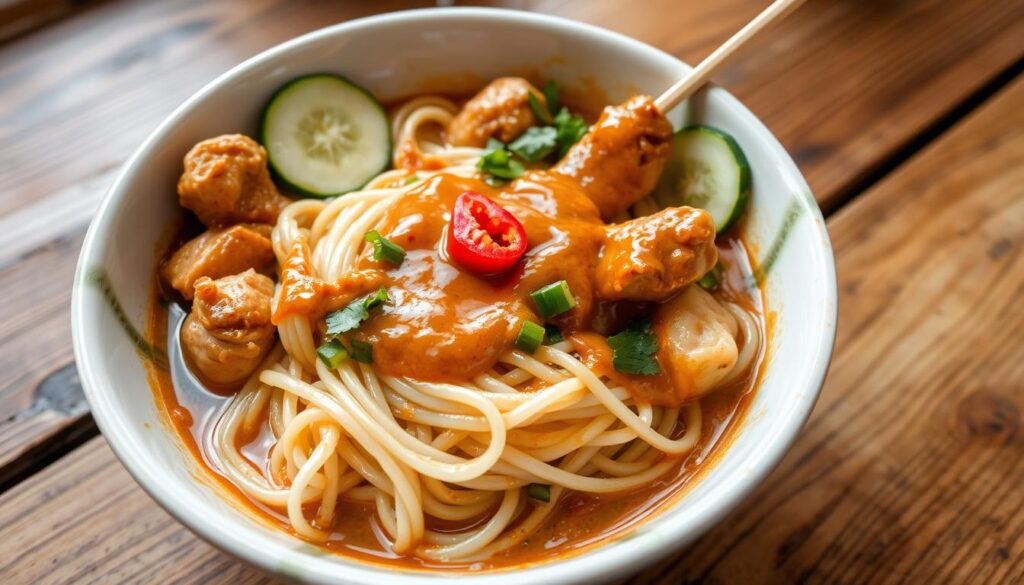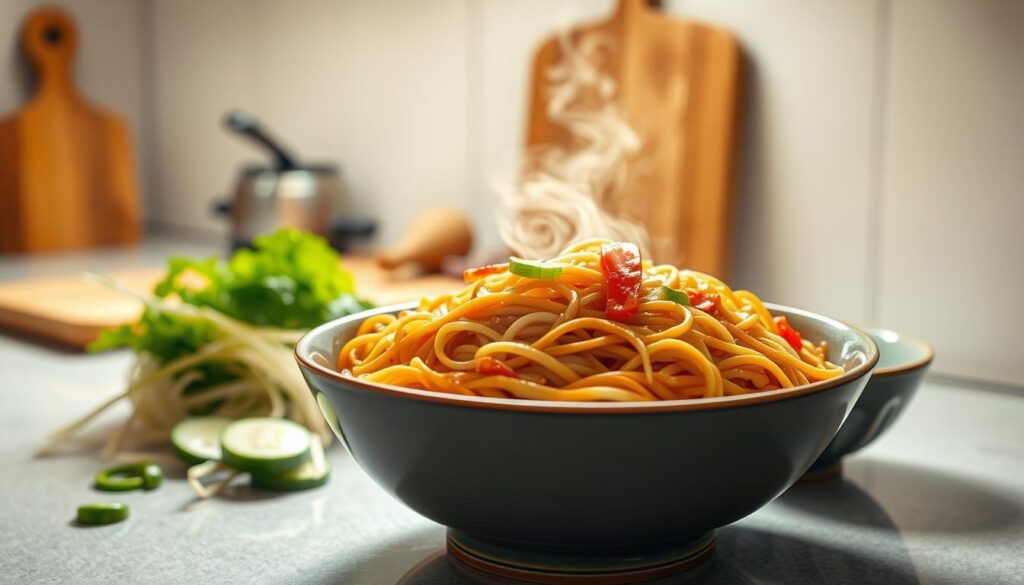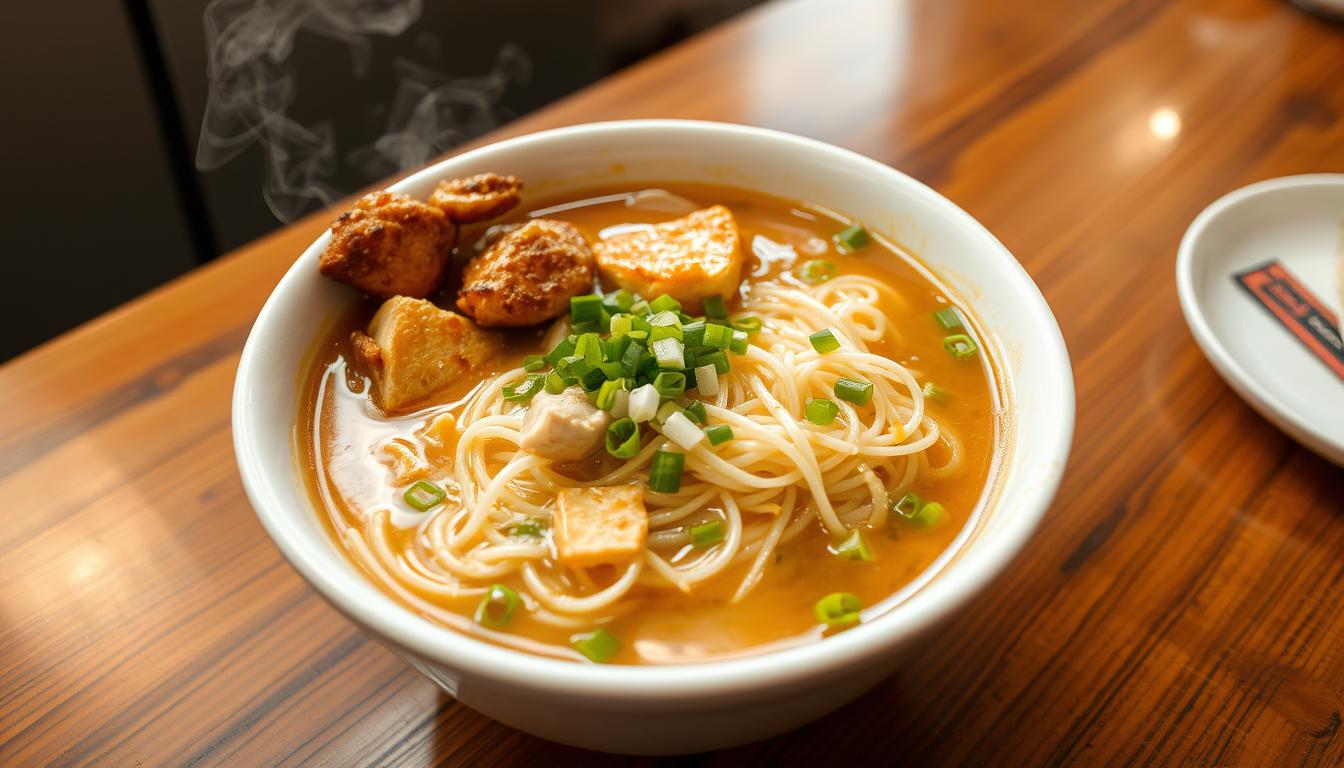Table of Contents
You’ve probably had your fair share of delicious noodle dishes, but have you ever tried satay bee hoon recipe? This popular noodle dish is a staple in Singapore and Malaysia, known for its rich and flavorful peanut sauce.
Imagine a plate of steaming hot noodles topped with an assortment of ingredients, all brought together by the creamy sauce. It’s a dish that’s not only delicious but also deeply rooted in the culture of Singapore and Malaysia.
As you explore the world of Singaporean cuisine, you’ll discover that Satay Bee Hoon is a beloved dish that’s often served at hawker centers and restaurants. Its popularity stems from the perfect balance of flavors and textures, making it a must-try for anyone who loves trying new foods.
What is Satay Bee Hoon?
If you’re a food enthusiast, you’ve likely come across Satay Bee Hoon, a flavorful noodle dish that’s a staple in Malaysian and Singaporean cuisine. Satay Bee Hoon is more than just a meal; it’s a culinary experience that combines the richness of satay sauce with the simplicity of rice vermicelli noodles.
Brief History of Satay Bee Hoon
Satay Bee Hoon originated from the Teochew immigrants who cleverly combined their peanut sauce with Chinese ingredients like rice vermicelli and various meats. This fusion resulted in a dish that’s both familiar and innovative, reflecting the cultural melting pot of Southeast Asia.
The history of Satay Bee Hoon is a testament to the culinary creativity of the region, where different cultures come together to create something truly unique.
Cultural Significance in Malaysia and Singapore
In both Malaysia and Singapore, Satay Bee Hoon is more than just a popular street food; it’s a dish that holds cultural significance. It’s often served at hawker centers and food courts, where locals and tourists alike gather to enjoy a quick and delicious meal.
The cultural importance of Satay Bee Hoon lies in its ability to bring people together, transcending cultural boundaries with its rich and savory flavors.
Ingredients You Will Need
The foundation of a great Satay Bee Hoon lies in its ingredients. To make this dish, you’ll need to gather a few essential components that provide its signature flavor and texture.
Essential Ingredients for Authentic Satay Bee Hoon
To make an authentic Satay Bee Hoon, you’ll need the following essential ingredients:
- Rice vermicelli noodles
- Peanut sauce (satay sauce)
- Sliced pork
- Pork liver
- Various vegetables such as bean sprouts, carrots, and chives
These ingredients are crucial for creating the dish’s characteristic taste and texture.
Optional Add-Ins for Extra Flavor
If you want to enhance your Satay Bee Hoon, consider adding:
- Grilled chicken or shrimp for extra protein
- Fried shallots for added crunch
- Fresh cucumber slices for a refreshing contrast
- Top with chopped peanuts to enhance both texture and taste.
Optional additions like these can enhance the dish and boost its satisfaction.
Recommended Brands and Products
To ensure optimal results, opt for trusted, high-quality ingredient brands. For peanut sauce, brands like Kacang Putih or ABC are highly recommended. For rice vermicelli, look for brands that specialize in rice noodles.
Preparing the Satay Sauce
Preparing the satay sauce is a crucial step in enjoying authentic Satay Bee Hoon. The sauce is what gives the dish its rich, nutty flavor and creamy texture. Making it from scratch allows you to control the ingredients and tailor the taste to your preferences.
Key Ingredients for the Sauce
The satay sauce is primarily made from peanuts, which are roasted to bring out their natural oils and then ground into a smooth paste. Other essential ingredients include chilies, garlic, ginger, soy sauce, and coconut milk, which add depth and complexity to the sauce.
- Roasted peanuts
- Red or green chilies
- Garlic cloves
- Fresh ginger
- Soy sauce
- Coconut milk
- Lime juice
- Sugar
- Salt
Step-by-Step Instructions to Make the Sauce
To make the satay sauce, start by roasting a cup of peanuts in a pan until they’re lightly browned. Let them cool before grinding them into a fine paste using a food processor or blender.
- Heat some oil in a pan and sauté chopped chilies, garlic, and ginger until fragrant.
- Combine ground peanuts, soy sauce, coconut milk, lime juice, sugar, and salt in the pan.”
- Simmer the mixture over low heat, stirring constantly, until it thickens into a smooth sauce.
- Taste and adjust the seasoning as needed.
Your satay sauce is now ready to be used in your Satay Bee Hoon. Refrigerate any leftover sauce in a sealed container and use within a week.
Cooking the Bee Hoon Noodles
To achieve the best satay bee hoon recipe, it’s essential to cook the Bee Hoon noodles correctly. Satay bee hoon traditionally features rice vermicelli noodles, which need careful handling to achieve the ideal texture.
Choosing the Right Type of Noodles
Rice vermicelli noodles are favored for satay bee hoon thanks to their lightness and delicate consistency. They absorb the flavors of the satay sauce beautifully, making them an integral part of the dish.
Look for rice vermicelli noodles that are made from high-quality rice flour. Recommended options include brands like XYZ Noodles and ABC Rice Vermicelli. These brands offer consistent quality and texture.
Cooking Techniques for Perfect Textures
Cooking Bee Hoon noodles requires attention to detail. Here’s a simple step-by-step guide:
- Boil water in a large pot.
- Add the rice vermicelli noodles and cook for 3-5 minutes, or until they are slightly soft but still retain some firmness.
- Quickly drain the noodles and rinse under cold water to halt further cooking
- Gently toss the noodles to loosen them and avoid clumping.
By following these steps, you can achieve perfectly cooked Bee Hoon noodles that complement the satay sauce beautifully, making your satay bee hoon dish a success.
Combining the Ingredients
To bring Satay Bee Hoon to life, you need to combine the cooked noodles, satay sauce, and various toppings effectively. This step is crucial as it brings together the flavors and textures that make Satay Bee Hoon a beloved dish.
Layering the Flavors
The key to a delicious Satay Bee Hoon is in the layering of its flavors. Start by placing a layer of cooked bee hoon noodles in a bowl, followed by a generous amount of satay sauce. You can then add your choice of toppings, such as chicken, prawns, or tofu, and finish with a sprinkle of chopped nuts and fresh herbs.
Tips for Layering:
- Ensure the noodles are not overcooked, as they will continue to absorb the sauce.
- Adjust the amount of satay sauce according to your preference for sauciness.
- Choose toppings that complement the flavor of the satay sauce.
Tips for a Balanced Dish
A balanced Satay Bee Hoon dish is one where all the elements flavor, texture, and temperature—come together in harmony. To achieve this, consider the following tips:
- Balance the flavors by adjusting the amount of satay sauce and the toppings. If it’s too spicy, add a squeeze of lime juice.
- Texture variety is key. Include a mix of soft noodles, crunchy nuts, and tender protein.
- Serve right away to savor the dish while it’s perfectly warm.
Serving Suggestions
When it comes to serving Satay Bee Hoon, the right accompaniments and plating can make all the difference. You can elevate this Singaporean satay bee hoon dish by adding a few simple yet flavorful elements to your presentation.
Ideal Accompaniments
To complement the rich flavors of Satay Bee Hoon, consider serving it with a side of chili sauce or fresh vegetables. You can also add sliced cucumbers, carrots, or bean sprouts to add crunch and freshness. If you prefer a bit of spice, a dollop of sambal chili sauce can enhance the overall flavor profile.
Plating Tips for Presentation
Presentation is key to making your satay bee hoon recipe visually appealing. Start by placing a portion of the noodles on a plate, then drizzle the satay sauce generously over the top. Garnish with chopped peanuts, sliced chilies, and a sprinkle of fresh cilantro for added color and texture. For a more authentic touch, serve it in a traditional Malaysian or Singaporean-style plate or bowl.

By paying attention to these details, you can create a dining experience that’s both authentic and visually appealing, making your Satay Bee Hoon a hit with family and friends.
Variations of Satay Bee Hoon
Exploring different variations of Satay Bee Hoon can elevate your dining experience. This popular Malaysian noodle dish is not only delicious but also versatile, allowing you to experiment with various ingredients and flavors.
You can modify the traditional Satay Bee Hoon recipe to suit your dietary preferences or taste buds. For instance, you can create a vegetarian version or spice it up to give it an extra kick.
Vegetarian Alternatives
If you’re a vegetarian, you don’t have to miss out on the Satay Bee Hoon experience. You can substitute the meat with plant-based protein sources such as tofu or tempeh. Additionally, you can use vegetable broth instead of chicken or beef broth to keep the dish flavorful and meat-free.
- Use tofu or tempeh as a protein substitute.
- Replace meat broth with vegetable broth.
- Add more vegetables like bell peppers or carrots.
Spicy Versions to Try
For those who enjoy spicy food, you can easily turn your Satay Bee Hoon into a spicy delight. Adding more chili or using spicy satay sauce can significantly enhance the flavor.
- Add sliced chilies or chili flakes to the dish.
- Use a spicy satay sauce recipe.
- Include other spicy ingredients like sriracha or hot sauce.
By experimenting with these variations, you can enjoy a unique easy satay bee hoon that’s tailored to your taste. Whether you prefer it vegetarian or spicy, the key is to balance the flavors so that the dish remains harmonious and delicious.
Feel free to get creative and make the best satay bee hoon recipe your own by incorporating your favorite ingredients or dietary preferences.
Tips for the Best Results
For a truly delicious Satay Bee Hoon, avoiding common mistakes and knowing how to store leftovers is essential. Making this dish at home can be a delightful experience if you follow some key guidelines.
Common Mistakes to Avoid
A frequent misstep in making Satay Bee Hoon is cooking the noodles too long. To achieve the perfect texture, cook the bee hoon noodles until they are just tender, as they will continue to cook a bit after being drained. Another critical error is not balancing the flavors. Make sure the satay sauce is smooth and flavorful, tweaking the seasoning as needed.
- Overcooking the noodles
- Not balancing the flavors
- Using low-quality satay sauce ingredients
Storing Leftovers Properly
Proper storage is key to preserving the quality of any leftovers. Keep the noodles and satay sauce in separate airtight containers to avoid sogginess. When reheating, gently warm the sauce and noodles separately before combining them.

With these tips, your Satay Bee Hoon will still taste great even when reheated. Remember, the key to an authentic Satay Bee Hoon lies in the details, from preparation to storage.
Pairing with Drinks
To enhance your Satay Bee Hoon experience, consider pairing it with a suitable beverage. The right drink can complement the dish’s complex flavors, making your meal even more enjoyable.
Best Beverage Choices for Satay Bee Hoon
When it comes to pairing drinks with Satay Bee Hoon, there are several options to consider. Tea is a traditional choice that pairs well with the dish’s savory and slightly sweet flavors. For those looking for something a bit more modern, craft beers can offer a refreshing contrast to the rich flavors of Satay Bee Hoon.
Traditional vs. Modern Pairings
Traditional pairings for Satay Bee Hoon often include Chinese tea or local herbal teas, which help to cleanse the palate between bites. On the other hand, modern pairings might feature craft beers or even signature cocktails designed to complement the dish’s unique flavors. Whether you prefer traditional or modern pairings, The goal is to strike a balance that elevates the overall dining experience.
For a Singaporean satay bee hoon recipe, you might want to try pairing it with a local favorite like teh tarik (pulled tea), which combines the robustness of black tea with the sweetness of condensed milk. Alternatively, a crisp Asian lager can also pair nicely with the dish’s spicy and savory notes.
Where to Find Satay Bee Hoon in Singapore
Singapore is a food haven, and satay bee hoon is one of its beloved dishes that you can find at various restaurants and food markets. If you’re looking to try this delicious noodle dish, here are some popular places to explore.
Popular Restaurants Offering Satay Bee Hoon
Some well-known stalls and restaurants in Singapore serve exceptional satay bee hoon. For instance, Sin Chew Satay Bee Hoon and Shi Wei Da are popular among locals and tourists alike for their authentic flavors.
- Sin Chew Satay Bee Hoon: Known for its rich satay sauce and perfectly cooked noodles.
- Shi Wei Da: Offers a unique twist on the traditional recipe with added flavors.
- Other notable mentions include stalls at Newton Food Centre and Tiong Bahru Market.
Local Food Markets to Explore
Singapore’s local food markets, also known as hawker centers, are a great place to try satay bee hoon. Some of the must-visit markets include:
- Maxwell Food Centre: A popular destination for foodies, offering a variety of satay bee hoon stalls.
- Adam Road Food Centre: Known for its wide selection of local dishes, including satay bee hoon.
- Tiong Bahru Market: A favorite among locals, offering a range of satay bee hoon options.
When exploring these markets, be sure to try different variations and ask locals for recommendations to get the best satay bee hoon experience.
Conclusion: Enjoying Satay Bee Hoon at Home
Now that you’ve learned the secrets of making delicious Satay Bee Hoon, it’s time to try it out in your own kitchen. This simple satay bee hoon recipe lets you enjoy the bold flavors of this Malaysian noodle dish anytime you like.
Making it Your Own
Customize your satay bee hoon by adding preferred ingredients or adjusting the heat to match your taste. Try swapping in different proteins or vegetables to craft a version that’s uniquely yours.
Sharing Your Experience
We’d love to hear about your experience making Satay Bee Hoon at home. Share your tips, variations, or photos of your dish on social media, and inspire others to try this easy satay bee hoon recipe.
FAQ
What is Satay Bee Hoon?
Satay Bee Hoon is a popular Malaysian noodle dish made with rice vermicelli noodles, satay sauce, and various toppings, often including chicken, prawns, or pork.
What are the essential ingredients for authentic Satay Bee Hoon?
The essential ingredients include rice vermicelli noodles, satay sauce, protein sources like chicken or prawns, and various vegetables such as bean sprouts and cucumber.
How do I make satay sauce from scratch?
To make satay sauce, you’ll need ingredients like peanuts, coconut milk, soy sauce, and spices. Blend the peanuts into a fine paste, then mix with coconut milk and other ingredients, and simmer until thickened.
What type of noodles should I use for Satay Bee Hoon?
Rice vermicelli noodles, also known as Bee Hoon, are the traditional choice for Satay Bee Hoon. Look for thin, translucent noodles made from rice flour.
Can I make a vegetarian version of Satay Bee Hoon?
Yes, you can make a vegetarian version by substituting the protein sources with tofu or tempeh and ensuring that the satay sauce is free from animal products.
What’s the best way to get perfectly textured noodles?
To achieve the perfect texture, cook the Bee Hoon noodles according to the package instructions, typically by soaking them in hot water until they’re tender but still slightly firm.
What are some common mistakes to avoid when making Satay Bee Hoon?
Common mistakes include overcooking the noodles, using too much satay sauce, and not balancing the flavors. Be mindful of these to ensure a delicious dish.
How should I store leftovers of Satay Bee Hoon?
Refrigerate any leftovers in a sealed container and consume within 24 hours. Reheat gently, adding a bit of water if the sauce has thickened too much.
What beverages pair well with Satay Bee Hoon?
Traditional pairing options include tea or coffee, while modern choices might be a refreshing glass of iced tea or a citrus-infused water.
Where can I find Satay Bee Hoon in Singapore?
You can find Satay Bee Hoon at various hawker centers and food courts throughout Singapore, as well as in some specialty restaurants.
Can I experiment with different variations of Satay Bee Hoon?
Absolutely! Feel free to experiment with different protein sources, spice levels, and additional ingredients to create your own unique version of Satay Bee Hoon.

